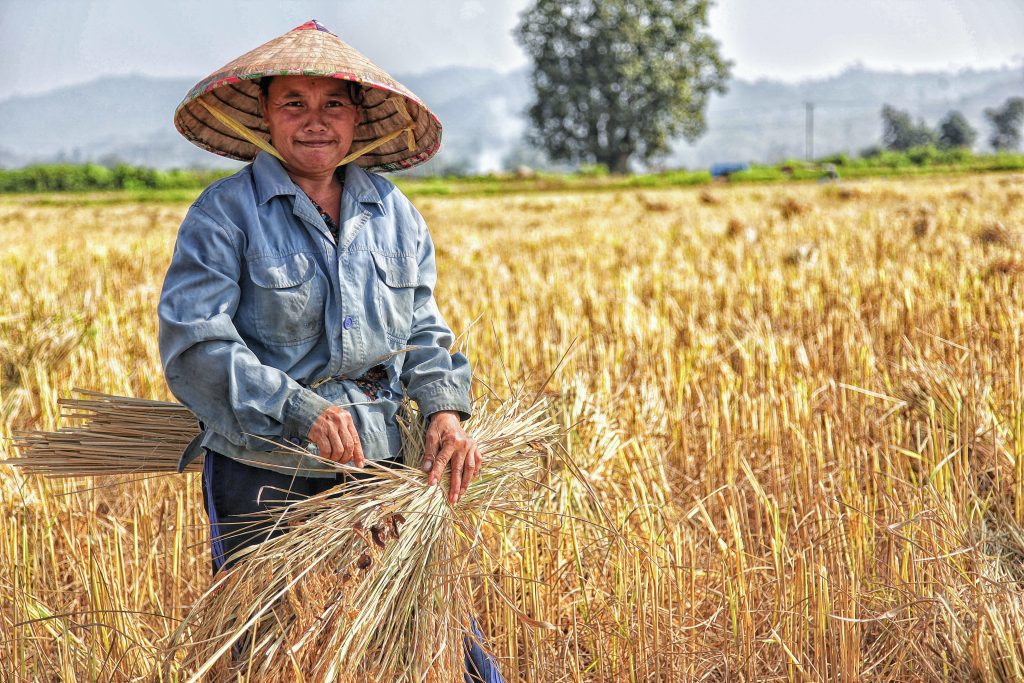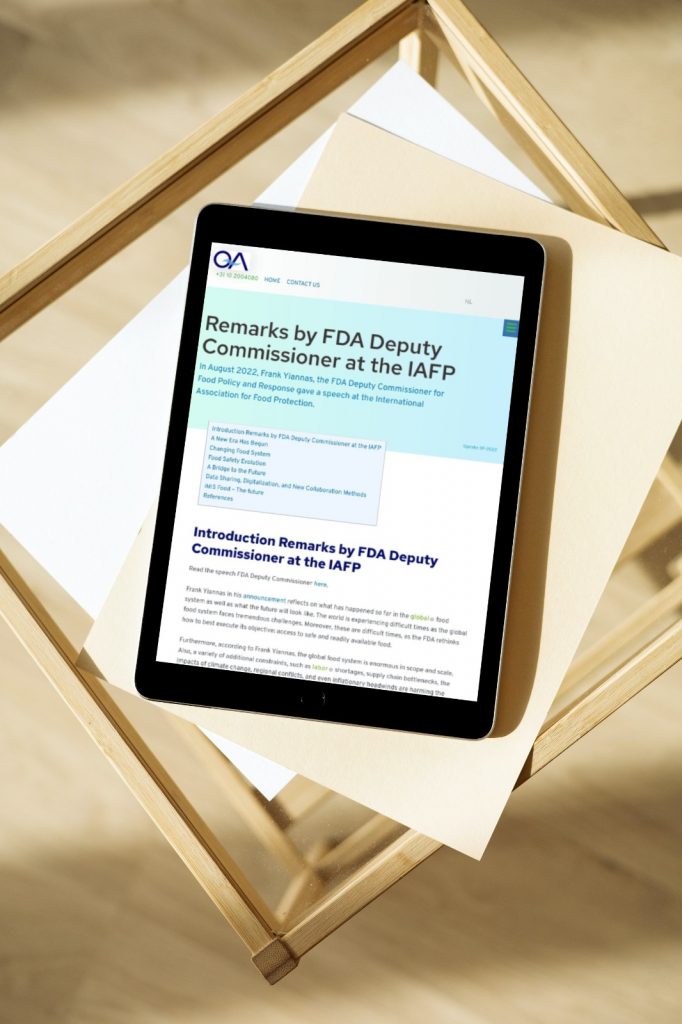Unexpected allergens
Allergen management can be very complex, especially on a global scale. Read more about it in ‘Global allergy management‘. Allergen management can be perceived as simple, using an egg product in a mixed product. The egg has to be declared in the ingredient declaration. Simple as that. However, allergy management comes with a lot of complexity. Therefore, the following table has been constructed, to ensure cross-contamination is prevented or limited. For, example, antioxidants are added to your product. How are the antioxidants produced and where they derived from egg or soy, could this potentially impact the processing facility or certain procedures.
Table
| Acidity regulator – lactate (326, 327, 328, 329) | What is it derived from (e.g. lactic acid (milk) or whey (milk), pork, etc.)? | |
| Acidity regulator – lactic acid (270) | What is it derived from (e.g. milk, tomatoes, molasses, potato, maize starch, wheat starch)? | |
| Albumin / albumen | What is it derived from (e.g. egg, milk etc.)? | |
| Amylase (alpha & beta) | What is it derived from (e.g. pig, wheat, barley, soy etc.)? | |
| Antioxidants | What are they derived from (e.g. soy, egg)? | |
| Baking powder / bicarbonate of soda | Does this contain any carriers or bases or anti-caking agents (e.g. wheat flour, rice flour etc.)? | |
| Is the line shared with other foods (e.g. milk)? | ||
| Banana chips | What oil was used in the preparation of this product? Peanut oil has been reported to have been used. Refer to section on Fat / Oil. | |
| Beta-carotene | Does it contain tocopherols and what are they derived from (e.g. soy)? Refer to section on Tocopherols. | |
| Is it microencapsulated? If so, what is the capsule/coating derived from (e.g. fish)? | ||
| Beta-galactosidase | Does it contain milk? | |
| Beverage whitener | Does it contain wheat, soy, casein (milk) etc.? | |
| Binders | Do they contain milk, egg, cereals containing gluten? | |
| Is the line shared with other foods (e.g. lupin, soy, other cereals containing gluten)? | ||
| Breadcrumbs | Do they contain sesame seeds? | |
| Are all possible bread sources considered (i.e. this is often a ‘rework’ product)? Other bread sources can contain lupin, soy etc. in addition to a range of cereals. | ||
| Is the bread used for the breadcrumbs glazed with milk or egg? | ||
| Brine | Check for allergens (e.g. casein (milk)). | |
| Caramel | What is it derived from (e.g. wheat, maize, sugar beet, cane sugar etc.)? | |
| Carotenoids | Are they microencapsulated? If so, what is the capsule/coating derived from (e.g. fish, crustacea)? | |
| Cereals | Is it a product of / does it contain wheat, oats, rye, barley, spelt, including hybridised strains? | |
| Cheese | Does it contain rennet (refer to section on Rennet), vinegar (refer to section on Vinegar), gelatine (refer to section on Gelatine), lysozymes (refer to section on Lysozymes), starch (e.g. Edam & Gouda cheese) (refer to section on Starch)? | |
| Cheese (grated) | wheat starch, wheat flour, maize etc.)? Refer to section on Cheese. | |
| Cheese powder | Does it contain anti-caking agent? If yes, what is it and what is it derived from (e.g. | |
| wheat starch, wheat flour, maize etc.)? Refer to section on Cheese. | ||
| Cocoa powder | Does it contain soy lecithin or wheat flour? | |
| Coconut / desiccated coconut | Does it contain added sulphites? | |
| Coconut milk / coconut milk powder | Does it contain milk components such as casein? Is the processing line shared with other foods (e.g. milk)? | |
| Colour(s) | Is there a carrier? If yes, what is the carrier derived from? Does it contain maltodextrin (refer to section on Maltodextrin), starch (refer to section on Starch), Yeast/yeast extract (refer section on yeast), soy, cereals containing gluten? | |
| Check for the addition of sulphites. | ||
| Colour (101) – riboflavin | What is it derived from (e.g. yeast)? Refer to section on Yeast/yeast extract. | |
| Colour (153) – carbon black or brilliant black | Does it contain glucose? Refer to section on Glucose. | |
| Colour (160a) – beta carotene | Is it microencapsulated? If so, what is the capsule/coating derived from (e.g. fish gelatine)? | |
| Colour (161) – xanthophylls | What is it derived from (e.g. animal, egg, egg yolk, crustacea, fish)? | |
| Corn | Does this refer to maize or wheat? Some countries use the terms “corn” and “wheat” interchangeably. | |
| Cornflour / corn starch | Is this derived from wheat or maize flour? | |
| Cultures | Check for milk. | |
| Curry paste / curry powder | What are the ingredients (including compound ingredients)? Do they contain allergens? | |
| Check for possible allergens associated with agricultural co-mingling (not just added allergens). | ||
| Dates | Do they contain any anti-caking agents (e.g. wheat flour, oat flour etc.)? | |
| Dehydrated / dried products | Do they contain oils (used as a processing aid)? Refer to section on Fat / Oil. Refer to Table 2 (Allergens associated with agricultural co-mingling). | |
| Check for sulphites. Are sulphites naturally occurring? Are sulphites added as processing aids? What levels are the sulphites in finished dehydrated vegetables (e.g. onions, potato, chives, etc.)? | ||
| Dextrin / dextrose / maltodextrin | Is this derived from oats or wheat? | |
| Glucose syrups made from wheat starch may be exempt from mandatory declaration. Confirm if the dextrose etc. is exempt. Confirm that all exemption conditions are met. | ||
| Emulsifier | What is it derived from (e.g. soy, egg, wheat)? | |
| Emulsifier – calcium stearate / stearic acid (570) | What is it derived from (e.g. peanuts)? | |
| Emulsifier – sodium lactylates / calcium stearoyl lactylate (481) | What is it derived from (e.g. peanuts, milk)? | |
| Enzymes | Do they contain carriers? Is the carrier from a wheat source? What is the fermentation substrate used to grow the enzymes? | |
| Ethanol | What is it derived from (e.g. wheat, whey (milk))? | |
| If derived from wheat or milk, is it exempt from mandatory allergen declaration? Confirm that all exemption conditions are met. | ||
| Fats / oils (including cold- pressed oils, animal fats and vegetable oils) | Does it contain antioxidants? Refer to section on Antioxidants. | |
| Check for the addition of soy tocopherols. Refer to section on Tocopherols. Animal fat/oil – what is it derived from (e.g. ghee (milk))? | ||
| Vegetable oil- what is the source of the oil (e.g. soy, peanut, sesame, canola, olive, sunflower etc.)? Has it been exposed to other oils manufactured/processed in the same facility (e.g. tree nuts, peanut, sesame)? If soybean oil is present, is it exempt from mandatory allergen declaration? Confirm that all exemption conditions are met. Cold pressed oil, expeller pressed oil, or extruded oil – these oils are not highly refined and may still contain protein. Has the oil been exposed to other cold pressed oils etc., manufactured/processed in the same facility (e.g. tree nuts, peanut, sesame)? | ||
| Fatty acids (mono and di- glycerides) | What are they derived from (e.g. soy)? | |
| Flavour enhancers (620, 621,622, 623,624, 625, 627, 631, 635) | What are they derived from (e.g. meat, sardines (fish), wheat, soy, maize)? | |
| If microbial synthesis occurs, what is the source of the nitrogen and carbohydrate (e.g. wheat, soy, maize etc.)? | ||
| Flavours | What are they derived from (e.g. wheat, maize, soy, egg, peanut)? Do they contain or are a product of allergens (e.g. milk)? | |
| Do they contain any bases, carriers, anti-caking agents? If yes, what are they derived from? | ||
| Does it contain maltodextrin (refer to section on Maltodextrin), casein (milk), oleoresins (refer to section on Oleoresins), emulsifiers (refer to section on Emulsifiers), oils (refer to section on Fat / Oil)? | ||
| Do they contain hydrolysed protein? Refer to section on Hydrolysed Proteins. Do they contain yeasts or yeast extracts? Refer to section on Yeast/yeast extract. | ||
| Do they contain fatty acids (e.g. mono-, di- or triglycerides?) Refer to section on Fatty Acids. | ||
| Have they been microencapsulated with fish gelatine? | ||
| Fruit | Check waxes/coatings applied to fruits for allergens. | |
| Gelatine | What is the gelatine derived from (e.g. isinglass (fish), beef, pork, chicken etc.)? Check for the addition of sulphites. | |
| Gellan gum | What is the carbohydrate source used to grow the gum (e.g. wheat, maize, molasses, cane sugar)? What is the protein source used to grow the gum (e.g. soy, egg)? | |
| Glaze | Does it contain egg or milk? | |
| Glucose / glucose syrup | What is it derived from (e.g. wheat, maize, rice, potato, oats etc.)? | |
| Glucose syrups made from wheat starch may be exempt from mandatory declaration. Confirm that all exemption conditions are met. | ||
| Glycerine | Check for peanut. | |
| Herb extract(s) | Do they contain any bases, carriers, anti-caking agents (e.g. maltodextrin, flour, oleoresins, emulsifiers)? If yes, what are they derived from (e.g. wheat, maize, soy, egg etc.)? | |
| Herb(s) | Do they contain any bases, carriers, anti-caking agents (e.g. maltodextrin, flour, oleoresins, emulsifiers)? If yes, what are they derived from (e.g. wheat, maize, soy, egg)? | |
| Hydrolysed animal protein | What is it derived from? Is it a product of casein or whey (milk), egg, fish? | |
| Note: Hydrolysed allergen proteins may be difficult to detect through analysis and may be allergenic even when not detected. | ||
| Hydrolysed vegetable protein | What is it derived from? Is it a product of soy, wheat, maize, peanut, sesame etc.? Note: Hydrolysed allergen proteins may be difficult to detect through analysis and may be allergenic even when not detected. | |
| Icing sugar | Is it 100% pure icing sugar? If not, what else is added (e.g. wheat)? | |
| Isoflavones | Are they derived from soy? | |
| Lecithin | What is it derived from? Is it a product of soy, egg etc.? | |
| Note: In some countries, certain soy lecithin products may be exempt from allergen declaration. Check the Code carefully to determine the declaration requirements in Australia and New Zealand. | ||
| Lysosyme | What is it derived from? Is it a product of egg? If checking for the presence of egg | |
| protein, ensure appropriate test method is used (such as the lysozyme ELISA method). | ||
| Malt / malt extract | What is it derived from (e.g. cereals containing gluten such as wheat, barley)? | |
| Maltodextrin | Check for wheat and added sulphites. | |
| Glucose syrups made from wheat starch may be exempt from mandatory declaration. Confirm if the maltodextrin is exempt. Confirm that all exemption conditions are met. | ||
| Mayonnaise | What are the ingredients (including compound ingredients)? Do they contain allergens (e.g. egg, milk, soy)? | |
| Meat (including manufactured – fish, meat, poultry, smallgoods) | Does it contain binders? If yes, do the binders contain milk, egg, cereals containing gluten? | |
| Does this product contain fillers? If yes, do the fillers contain soy, cereals containing gluten? | ||
| Does it contain cure/brine premixes, or massage mixes? If yes, do they contain milk, egg? | ||
| Does it contain seasoning premixes? If yes, do they contain wheat, egg, milk, soy? Refer to sections on Herb(s), Spice(s) and their extracts. | ||
| Does it contain processing aids such as lactoperoxidase (milk)? Does it contain sulphites? | ||
| Milk powder | Does it contain soy lecithin? | |
| Minerals | Are they microencapsulated with fish gelatine? | |
| Mustard | Does it contain wheat? Refer to Table 2 (Allergens associated with agricultural co- mingling). | |
| Non-dairy creamers | Milk derivatives have been reported in some non-dairy creamers. | |
| Oleoresins | Do they contain antioxidants/tocopherols or emulsifier? If yes, what are they derived from (e.g. soy, egg, sesame)? Refer to section on Tocopherols. | |
| Omega 3, 6 | Are they derived from fish, linseed etc.? Check for the addition of soy lecithin. | |
| Polyols (sugar alcohols) e.g. sorbitol (420) | What are they derived from (wheat, milk, tree nuts, maize etc.)? | |
| Some polyols such as sorbitol can be a product of glucose syrup derived from wheat starch, which may be exempt from mandatory declaration. Confirm that all exemption conditions are met. | ||
| Processing aids | Are there any processing aids derived from allergen sources? | |
| Rennet | What is it derived from (e.g. bovine or synthetic)? If synthetic, what is the source (e.g. maize, wheat, soy, molasses, sugar beet)? | |
| Rice flour | Does it contain wheat or other allergens from other plant sources (soy, lupin etc.)? | |
| Seasoning pre-mixes | Do they contain wheat, egg, milk, soy? Refer to sections on Herb(s), Spice(s) and their extracts. | |
| Shortening powder | Does it contain wheat, maize, casein (milk) etc.? | |
| Soy Sauce | Does it contain wheat (in addition to soy)? | |
| Spice extract(s) | Do they contain any bases, carriers, anti-caking agents (e.g. maltodextrin, flour, oleoresins, emulsifiers)? If yes, what are they derived from (e.g. wheat, maize, soy, egg etc.)? | |
| Spice(s) | Do they contain any bases, carriers, anti-caking agents (e.g. maltodextrin, flour, oleoresins, emulsifiers)? If yes, what are they derived from (e.g. wheat, maize, soy, egg)? | |
| Stabilisers | What are they derived from (e.g. soy, egg, cereals containing gluten)? | |
| Starch (including native or chemically or physically modified) | What is the starch derived from (maize, tapioca, potato, wheat)? Check for added sulphites. | |
| Sterols (plant) | For soybean derivatives that are phytosterols, confirm if allergen labelling exemptions apply. | |
| Suet | Check for cereals containing gluten. | |
| Sugar | What is it derived from (e.g. cane sugar, sugar beet, wheat)? | |
| Sulphites – sulphur dioxide, bisulphite, metabisulphite (220, 221, 222, 223, 224, 228) | What is the concentration of added sulphites? Check level of addition (mg/kg (ppm) or mg/100g)? | |
| Sultanas | Check for wheat starch used as an anti-caking agent. | |
| Textured vegetable protein | Does it contain wheat, soy? | |
| Thickener | What is the thickener derived from (maize, tapioca, potato, wheat) and what is the carrier material? | |
| Tocopherols | What are the tocopherols derived from (wheat, soy)? | |
| For soybean derivatives that are tocopherols, confirm if allergen labelling exemptions apply. | ||
| Triticale | Is this a wheat and rye hybrid? | |
| Vegetable Oil | Refer to section on Fats / oils (including cold-pressed oils, animal fats and vegetable oils) | |
| Vinegar | What is the vinegar derived from (e.g. wheat, barley, maize, malt, milk)? If balsamic vinegar, does it contain caramel? Refer to section on Caramel. | |
| For vinegars derived from alcohol distilled from whey (milk) or wheat – confirm if allergen labelling exemptions apply. | ||
| Vitamin E | Check for soy. Refer to section on Tocopherols. | |
| Vitamins / vitamin premix | Are they microencapsulated with fish gelatine? | |
| If spray-dried, confirm the medium (e.g. maltodextrin). Check for lactose (milk)) carriers. | ||
| Wine / wine vinegar | For wines and wine vinegars, are clarifying/fining agents used during the processing of wine (e.g. casein (milk), egg white, isinglass (fish), gelatine (beef, fish, chicken, pork) or chitosan (sourced from crustacea))? | |
| If isinglass is used as a clarifying agent, confirm if allergen labelling exemptions apply. Check for sulphites. | ||
| Worscestershire sauce | Check for the addition of anchovies (fish), soy. | |
| Xanthan gum | What is the carbohydrate source used to grow the gum (e.g. wheat, maize, molasses, cane sugar)? | |
| What is the protein source used to grow the gum (e.g. soy, egg)? | ||
| Yeast / yeast extract | What is the substrate the yeast is grown on (e.g. wheat, malt, barley, soy etc.)? Where barley and or wheat are used as a substrate – are they malted? | |
| Are there any carriers? Refer to section on Flavours. |
Related articles to Unexpected Food Allergens derived from ingredients
Many customers and visitors to this page 'Unexpected Food Allergens derived from ingredients' also viewed the articles and manuals listed below:



